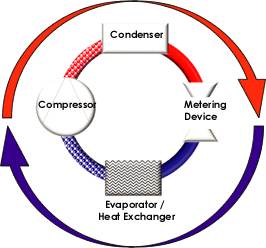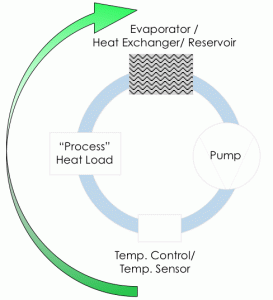The refrigeration circuit removes heat from the fluid using a refrigerant at a lower temperature and discharges it at a higher temperature to the air or a water source.
The refrigeration circuit has four basic components: The compressor, condenser, a metering device, and an evaporator which is also known as a heat exchanger.

The compressor pumps refrigerant gas from a low pressure to a high pressure. The high pressure, high temperature gas is changed into a liquid in the condenser, which removes heat energy from the refrigerant. The metering device reduces and regulates the pressure of the liquid refrigerant which also reduces the temperature at which it evaporates. The evaporator/heat exchanger takes advantage of the lower pressure and resulting lower evaporation temperature to remove heat from the process fluid that is flowing in the heat exchanger. This exchanges heat from the process fluid to the refrigerant. Each of these components are selected by size and type to work efficiently to remove the amount of heat being produced and at the temperature required by the application.
How is Cooling Measured?
One ton of refrigeration is the cooling power needed to freeze 1 ton (2000 lb) of 32°F (0°C) water to ice (at the same temperature) for 1 day (24 hours).
This is also known as the latent heat of a ton of ice per day.
1 ton(R) =
= 2000lb x 144 (BTU/lb) / 24 hr
= 288,000 BTU/24 hr
= 12,000 BTU/hr
= 3.517 kW
How Does the Process Circuit Work?
The process fluid circuit is thermally connected to the refrigeration circuit at the evaporator/heat exchanger. The process fluid, with the heat removed, is stored in a reservoir and pumped to the application where the fluid removes its heat and flows back to the chiller tank and heat exchanger to continue the cycle.
The process fluid will be maintained at a constant temperature and flow regardless of the heat load applied at the application. Some process circuits operate with multiple pumps, multiple cooling loops and can have other unique components.


